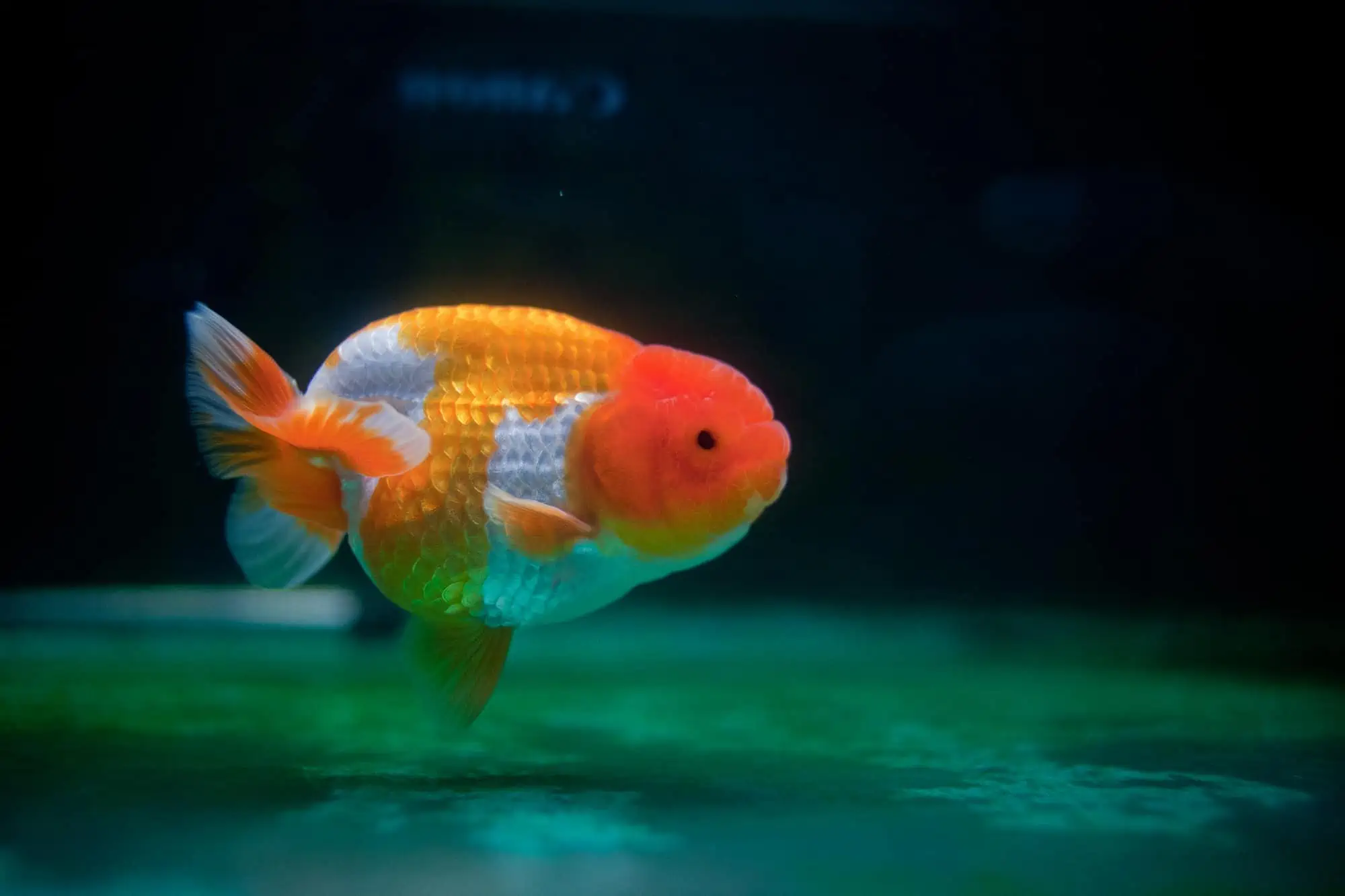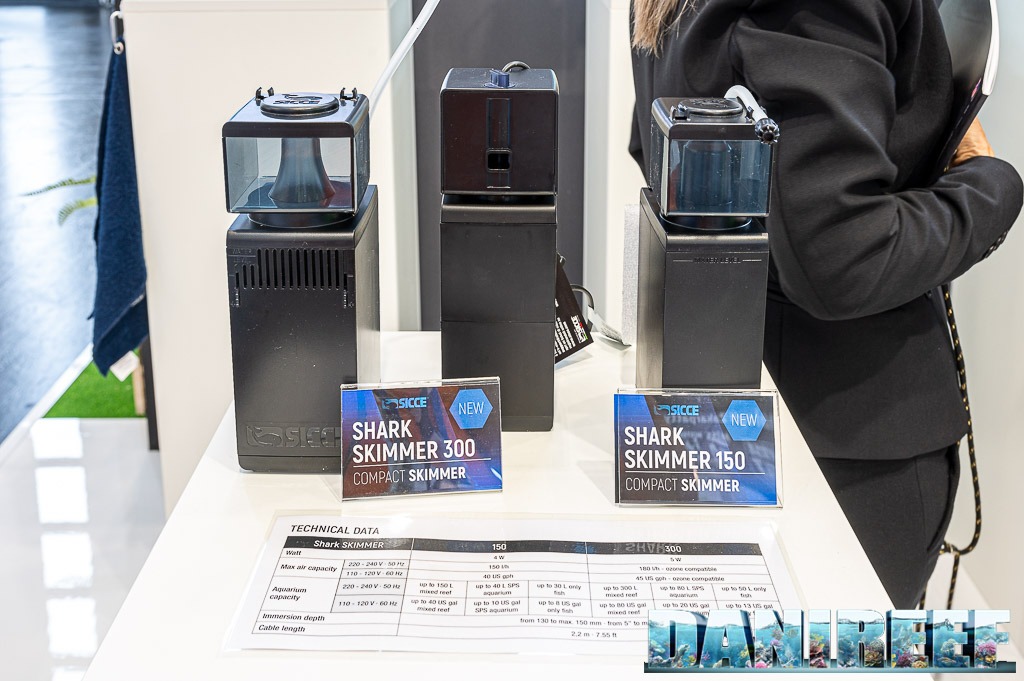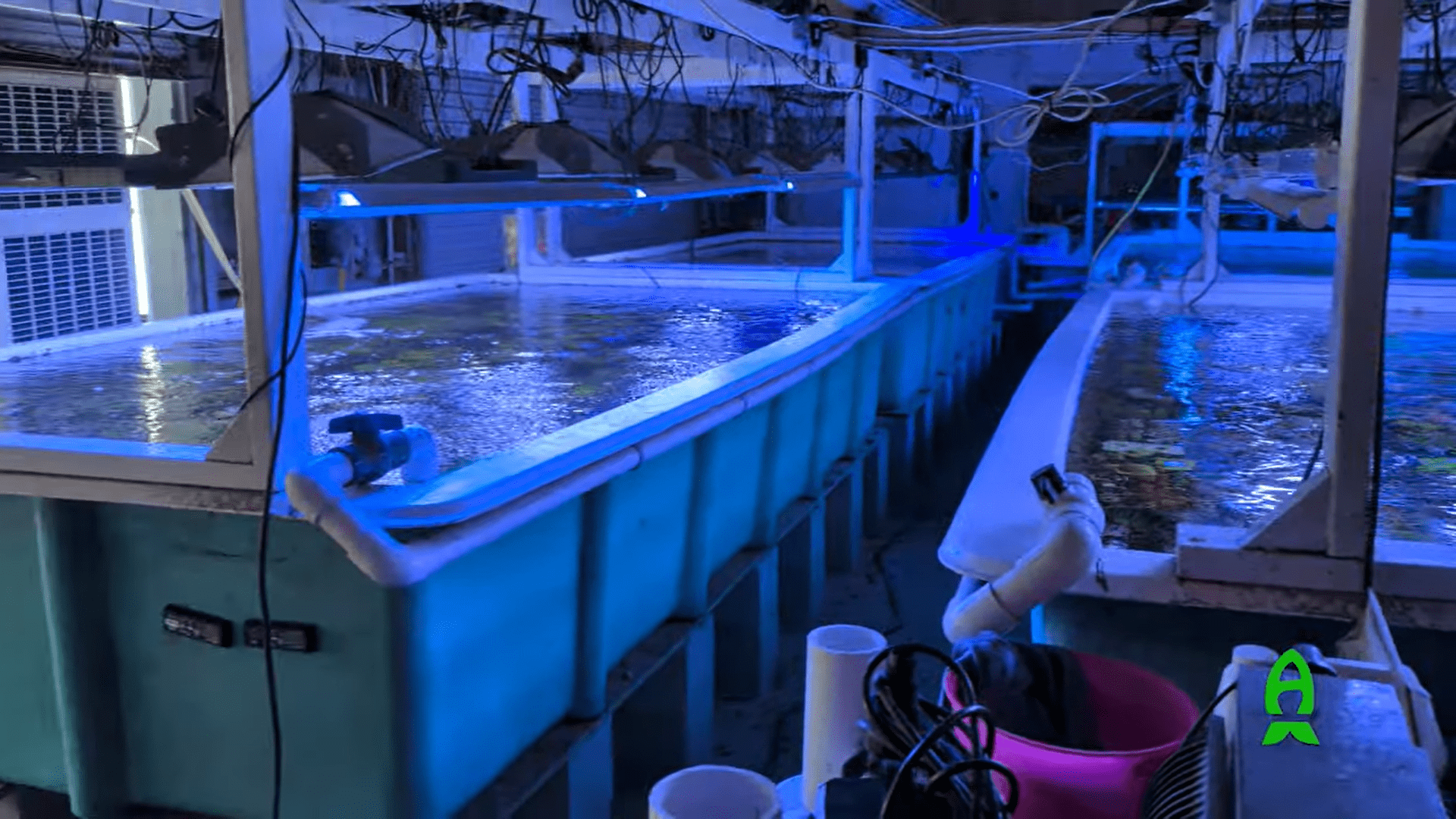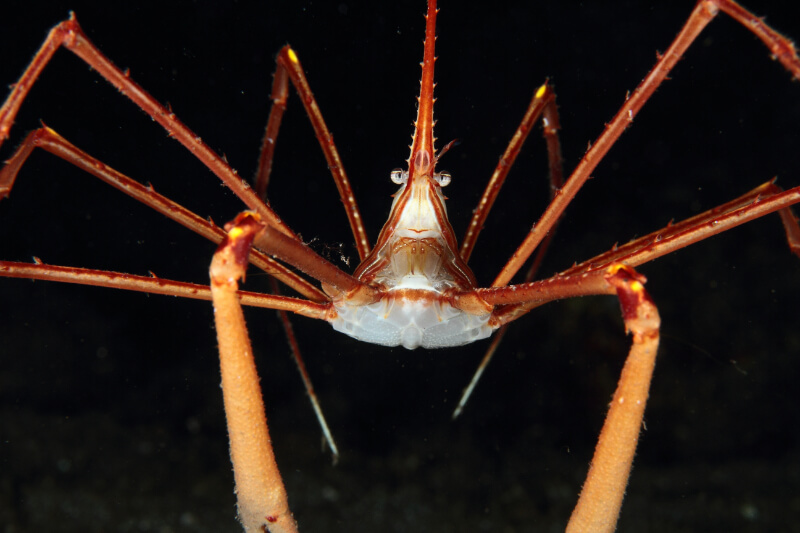If you’re in the market for a fancy goldfish, you may be considering a Ranchu goldfish. With their swollen heads and short bodies, Ranchu’s are one of the most iconic fancy goldfish varieties.
But Ranchu goldfish are also lacking a dorsal fin, causing some animal rights advocates to suggest the breed should be outlawed.
Let’s take a closer look at the Ranchu goldfish, and how to best care for them if you do decide to keep one.
Ranchu Goldfish Overview
| Ranchu Goldfish Info | |
|---|---|
| Scientific Name | Carassius auratus |
| Temperament | Peaceful |
| Lifespan | 8-15 Years |
| Care Level | Moderately difficult |
| Size | 5–8 inches |
| Minimum Tank Size | 30 Gallons |
| Diet | Omnivorous |
| Color | Varied, including red and white, solid red, black, calico, blue, yellow, orange and captivating mixtures |
Ranchu Goldfish Origin and Background
Also known as the Buffalo-head goldfish, the Ranchu goldfish is just one of more than a hundred captive-bred fancy goldfish breeds. They’re sometimes confused with the lionhead goldfish but are a distinct variety.
Fancy goldfish are also known as double-tailed goldfish because, well, they have two tails! These highly-bred varieties tend to grow smaller and suffer from more health problems than their single-tailed cousins.
Although all goldfish originally come from China, the Ranchu strain of goldfish originated in Japan and was first mentioned in historical records in 1648.
With their large, bulbous heads and round bodies, some enthusiasts find Ranchus adorable. Others don’t understand the appeal, and may even argue that such extreme mutations, such as a lack of dorsal fin, are unethical (see FAQs at the end).
Ranchu Goldfish Appearance
Ranchu goldfish are famous for their large, bulbous heads and short, round bodies, and absence of a dorsal fin (the central fin normally present on a fish’s back).
Classic Ranchus are gold and white in color, but specimens with black coloration are also available.
While it’s easy to find Ranchus with black speckles, the true ‘Black Ranchu Goldfish’ are completely black from tip to tail. Rarer still are varieties with purplish and silver pigments.
How Big Do Ranchu Goldfish Get?
Ranchu goldfish grow to around the same size as other fancy goldfish varieties, meaning in most aquariums they’ll grow up to between 5-8 inches long.
When given a very large aquarium or warm garden pond, however, they may get slightly bigger.
Ranchu Goldfish Care Guide
Tank Size
People often keep goldfish in tanks and enclosures that are far too small for them.
The wild ancestors of goldfish would have lived in large ponds and lakes, and grown to well over 12 inches in length.
It’s much better, therefore, if you can provide a large aquarium of at least 30 gallons for a baby rancho to grow up in, and increase the tank size to 55 gallons for mature specimens.
Tank Environment
Goldfish aren’t super fussy when it comes to their surroundings, but it’ll be a much more rewarding experience if you create an aesthetically beautiful and practical tank environment for them.
Pieces of driftwood can also look attractive but remember that raw driftwood can release tannins, making the water an amber color and more acidic.
As for substrate, gravel is your best choice for goldfish. It’s the easiest substrate to keep clean, which is a great asset when looking after these messy fish!
Round pieces of rock and stones can look great in a goldfish tank, but avoid rocks with rough or sharp edges since they can easily damage fancy goldfish scales and fins.
Aquatic Plants
Many people find it difficult to grow aquarium plants alongside goldfish because of their tendency to eat them or tear them out of the substrate. Because of this, some well-anchored synthetic plants may be a better option.
Vigorous floating plants like duckweed and Amazon frogbit may also grow faster than your goldfish can eat them, and perform a useful service in absorbing excessive nitrogenous waste from the water.
Water Temperature
Ranchu Goldfish are coldwater fish that prefer a water temperature of between 65-72°F. Although single-tail goldfish can tolerate water colder than this, fancy goldfish don’t do well in temperatures below 60°F, so they shouldn’t be kept in garden ponds in most regions.
The coldwater preference of goldfish makes them incompatible with most tropical fish that require warmer temperatures.
It’s important to note, though, that Ranchu Goldfish are sensitive to sudden changes in water temperature, so acclimatizing them properly in a new tank is essential to avoid thermal shock.
If their tank is sited in a particularly cold room, an aquarium heater will help to keep the temperature stable within the ideal range.
Water Parameters
Goldfish are relatively unfussy when it comes to their water chemistry. A fairly neutral pH of between 6.5-7.5 is ideal, but they’ll also tolerate pH conditions of between 6-8.
Try to keep the carbonate hardness of the water above 4 dKH to guard against sudden changes in the water’s pH.
Filtration
Goldfish are some of the messiest fish you can keep, so should never be kept without an effective aquarium filter!
Hang-on-back filters, internal power filters, or a canister filter are all good options for goldfish, but you should take care not to overwhelm fancy goldfish fish with a strong current.
Because they are highly bred and fairly weak-swimming, fancy goldfish won’t enjoy swimming against a strong filter flow.
Some filters allow you to manually adjust the flow rate. On other models, you can reduce the water current by using an aquarium spray bar, or lily pipe.
Feeding
Like other Ranchu Goldfish are phenomenally greedy and will eat almost anything you throw at them. Be careful, therefore, to only feed them high-quality foods and not to overfeed them.
Overfeeding is probably the greatest cause of ill health in goldfish for 3 reasons:
- Overfed goldfish can easily develop digestive problems, and bloat, leading to swim bladder disorder.
- Overfed goldfish will produce more digestive waste which pollutes their tank water.
- Any uneaten food will rot and contaminate the tank water, leading to potentially fatal conditions.
Therefore only feed your goldfish twice a day with no more food than they eat within 2 minutes.
High-quality specialized goldfish food is your best option for dried food for your goldfish, but note that dried fish foods should always be supplemented with live and/or frozen foods.
Bloodworms, tubifex worms, daphnia, brine shrimp, mosquito larvae, and vegetable supplements are all good options.
Compatible Tank Mates
Coldwater Fish
As I’ve already mentioned, Ranchu goldfish are coldwater fish, so can only be kept with other fish species that are tolerant of low water temperatures.
Other coldwater fish such as white-cloud mountain minnows and weather loaches are not recommended tank mates because they require much higher water quality than goldfish and also need highly-oxygenated water with a strong current which fancy goldfish hate.
Warmwater Fish
A better option is to keep Ranchu goldfish at the top end of their preferred temperature range (70-72°F) and keep them with the hardiest tropical fish.
Rosy barbs, gold barbs, and two-spot barbs can all tolerate water temperatures below 70°F, but may also nip at fancy goldfish fins. Zebra danios and pearl danios are more peaceful and can handle water temperatures in the mid-60s.
Buenos Aires tetra and bloodfin tetra are also hardy species, but be sure to keep them in schools of at least 6 fish to avoid stress and the possibility of them nipping at each other or at your goldfish’s fins.
Some algae-eating fish such as hardy cories and plecos can also be kept with goldfish under ideal conditions, you can check out my dedicated article on that here.
Health and Disease

Ranchu Goldfish are highly bred fish and tend to suffer more health problems than common goldfish.
As we’ve already covered, overeating is a major cause of ill health in goldfish and can easily result in constipation, bloating, swim bladder disorders, and also ammonia poisoning.
Goldfish are also subject to most of the same diseases as tropical fish. Ich, velvet, and flukes are all common parasitic diseases that can lie dormant in an aquarium for years until a weakened fish or very poor water quality offer them a chance to strike.
Similarly, bacterial and fungal infections like columnaris and water molds only tend to affect fish that are already in a vulnerable state.
As mentioned earlier, the slow-moving Ranchu goldfish is vulnerable to having their fins nipped by other species. Nipped fins can lead to fin rot – a bacterial infection that can later invade the rest of the body.
Sexual Dimorphism
There are a few ways that you can tell male and female goldfish apart.
For starters, male goldfish tend to be a little thinner than females, especially around the belly area. Females are often larger than males in all dimensions and get especially plump during the breeding season.
The pectoral fins and anal fins in goldfish are also longer and more pointed in males than in females.
Breeding Ranchu Goldfish
Goldfish aren’t the easiest fish to breed in an aquarium but will breed more readily when exposed to similar temperature shifts that they’d experience in a mild climate outdoors.
This is because their reproductive systems rely on climatic changes during the spring and early summer to induce courtship and spawning.
Those looking to breed goldfish in a fish tank need to simulate these natural climatic shifts by gradually raising the aquarium heater’s thermostat.
You can find out more about breeding goldfish in our dedicated article here.
Lifespan
When well-cared-for goldfish can live to a ripe old age. Single-tail goldfish have been known to live to 40 years!
Once again, fancy goldfish like Ranchus tend to live shorter lives than common goldfish, but healthy fish should live for between 8-15 years.
For them to reach their maximum lifespan, their diet, water quality, and quality of care must be of the highest order.
Tank Maintenance
Some top tips for keeping your Ranchu Goldfish in tip-top condition!
Buying Guide
As one of the most famous fancy goldfish varieties, Ranchu goldfish should be fairly easy to find if you shop around.
Typical Ranchus may only cost as little as $5, but rare varieties can fetch upwards of $100.
Always try to source your fish from reputable breeders and dealers, and observe them carefully for any signs of ill health, diseases, or swimming difficulties before you buy.
Ranchu Goldfish FAQs
Are Ranchu Goldfish Aggressive?
While Ranchu goldfish are not any more aggressive than any other type of goldfish, they are often smaller and weaker swimming than long-body goldfish like comet, sarasa, and shubunkin varieties.
This means they are more likely to be intimidated or, in extreme circumstances, bullied, by these larger, stronger varieties. In most instances, however, goldfish are social and fairly peaceful fish that won’t fight with each other or other similar-sized fish.
Are Ranchu Goldfish Ethical to Keep?
Some people are understandably concerned about intentionally breeding fish with mutations that could affect their quality of life.
While the bulbous head of the Ranchu goldfish might not seem as extreme as Bubble Eye Goldfish or Telescope Goldfish, their lack of dorsal fin is a considerable hindrance.
A scientific study by Blake et al. 2009 reports:
“Goldfish without dorsal fins have been shown to have slower swimming speed, slower acceleration and more inefficient locomotion than normal goldfish and have to cope with the tendency to roll to the side during movement or at rest and with having less directional stability.”
The Universities Federation for Animal Welfare has listed Ranchu goldfish as a fish variety that may be suffering as a result of their lack of a dorsal fin.
Please consider this point carefully before investing in a fancy goldfish. Goldfish live long lives, and they deserve to be happy ones. Single-tail varieties such as comets are renowned for being healthier and more robust than fancy-fin varieties.
Final Thoughts
Ranchu goldfish are a famous breed of fancy goldfish with a bulbous head and no dorsal fin. Their lack of dorsal fin concerns some fish keepers, and their long-term welfare must be considered before buying one.
If you’re looking for a goldfish that’s more likely to live a long and healthy life, consider a single-fin variety such as a Common Goldfish or Comet Goldfish.


